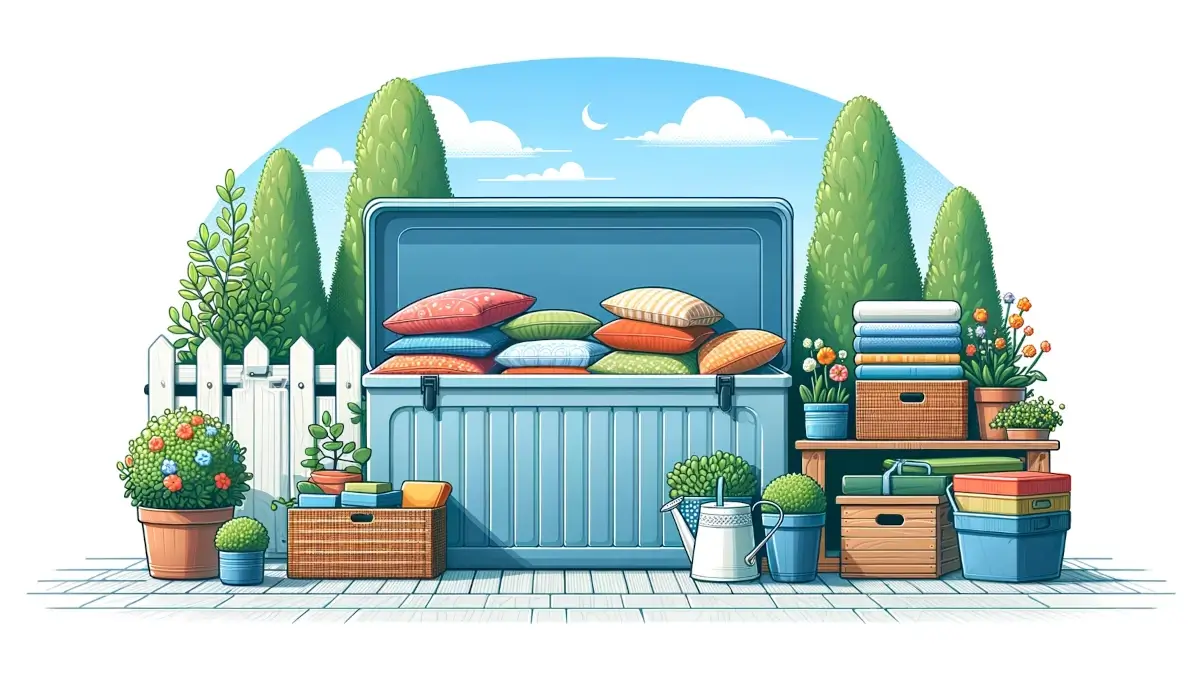How To Store Garden Cushions

Proper storage of garden cushions is essential to extend their lifespan and maintain their appearance. Exposure to elements like rain, sun, and temperature fluctuations can damage the fabric and padding, leading to quicker deterioration. By storing cushions correctly, you can protect them from weather-related wear and tear, ensuring they remain comfortable and visually appealing for outdoor relaxation.
Understanding garden cushions involves recognizing the different types available and the materials they’re made from, as these factors significantly influence their durability and suitability for outdoor use.
Types of Garden Cushions
Standard Seat Cushions: Designed for garden chairs, these are common and come in various shapes and sizes.
Lounger Cushions: Longer and more substantial, they’re made for loungers or recliners.
Bench Cushions: Rectangular cushions designed to fit garden benches.
Decorative Cushions: Smaller cushions used for aesthetic purposes or added comfort.
Related Article: Why use movers close to me?
Materials Used in Garden Cushions
Polyester: Popular for its durability and ease of cleaning, often treated for UV and water resistance.
Acrylic Fabrics: Higher-end option known for colorfastness and resistance to mildew and UV damage.
Cotton Canvas: Traditional material, not inherently weather-resistant but can be treated with waterproofing sprays.
Textilene: A mesh fabric made from polyester fibers coated in PVC, known for being weatherproof and durable.
Proper storage of garden cushions is crucial for several reasons, primarily related to their protection, longevity, and maintenance.
Impact of Weather and Elements
Weather Damage: Cushions left outdoors are susceptible to rain, UV rays, and temperature extremes, which can lead to fading, mildew, and deterioration of fabric and fillings.
Dirt and Debris: Unprotected cushions can accumulate dirt, leaves, and other outdoor debris, requiring more frequent cleaning.
Longevity and Maintenance
Prolonged Cushion Life: Storing cushions when not in use protects them from the elements, significantly extending their lifespan.
Reduced Maintenance: Proper storage keeps cushions cleaner, reducing the need for frequent washing or repair of weather-induced damage.
Related Article: Removal Boxes Or Plastic Crates?
Cleaning and Drying Cushions
Cleaning: Remove any dirt or stains from the cushions using appropriate cleaners depending on the fabric type. Avoid harsh chemicals that might damage the material.
Drying: Ensure cushions are completely dry before storage. Storing damp cushions can lead to mold and mildew growth, which can ruin them.
Checking for Repairs
Inspection: Examine cushions for any tears, loose threads, or weakened seams.
Repairs: Address any damage before storing the cushions. Mending minor issues can prevent them from becoming major problems later on.
Need help moving during the winter months? Our experienced Leicester movers will be the right fit for the job.

When it comes to storing garden cushions, selecting the right storage solution is key to preserving their condition. There are both indoor and outdoor storage options available, each with its benefits.
Indoor Storage Options
Closets: Utilize spare closet space to store cushions, protecting them from temperature extremes and pests.
Under-Bed Storage: A great space-saving solution, under-bed storage keeps cushions dry and dust-free.
Outdoor Storage Options
Storage Boxes: Weather-resistant storage boxes can be conveniently placed on your patio or in your garden, providing easy access and protection from the elements.
Sheds: For larger collections of cushions, a shed offers ample space and can protect against all weather conditions.

For those looking to store garden cushions without spending much, DIY storage ideas can be both creative and budget-friendly. Here’s a guide to crafting your own storage solutions:
Creative and Budget-Friendly Storage Solutions
Repurpose Old Furniture: Transform an old chest of drawers or a wardrobe into a storage space for cushions.
Use Pallets: Construct a simple storage box out of pallets, which are often available for free or at a low cost.
Hanging Solutions: Create a hanging system in your garage or shed using sturdy hooks and racks.
Step-by-Step Guide to Making Your Own Storage Space
- Choose Your Material: Decide on a budget-friendly material like pallets, reclaimed wood, or unused furniture.
- Design the Space: Plan the size and shape based on the number of cushions and available space.
- Gather Tools and Materials: Collect all necessary tools, like a saw, hammer, nails, and any paint or sealant for weatherproofing.
- Construction: Assemble the frame, add walls and a lid for boxes, or install hooks for hanging.
- Weatherproofing: Apply a coat of weather-resistant paint or sealant to protect against moisture and sun damage.
- Final Touches: Add hinges to lids for easy access and consider adding wheels for mobility.
Check how much your move will cost. It is free and no-obligation.
Seasonal considerations play a crucial role in the proper storage of garden cushions, as the needs and methods vary significantly between summer and winter. Understanding these differences ensures that your cushions are well-maintained year-round.
Storing Cushions for Summer
Ventilation: In summer, store cushions in a place with good air circulation to prevent mold and mildew.
Accessibility: Keep them in an easily accessible spot for spontaneous outdoor gatherings.
Storing Cushions for Winter
Dry and Clean Storage: Ensure cushions are thoroughly dry and clean before storing for the winter to prevent mold growth.
Protection from Cold: Store in a dry, indoor area to protect from cold and damp conditions that winter brings.
Tips for Long-Term Storage
Use Protective Covers: Invest in quality storage bags or covers to shield cushions from dust and pests.
Avoid Compression: Store cushions without stacking or compressing to maintain their shape and comfort.
Regular Checks: Periodically check on stored cushions, especially during seasonal transitions, to ensure they remain in good condition.
Regular maintenance of stored garden cushions is essential to ensure they remain in top condition, even when not in regular use. This involves periodic checks and airing out, which are key to preventing issues like mold, mildew, and unwanted odors.
Periodic Checks on Cushions
Inspect Regularly: Every few weeks, inspect the cushions for any signs of dampness, pests, or mold.
Address Issues Promptly: If you notice any problems, such as a musty smell or damp spots, address them immediately to prevent further damage.
Airing Out and Refreshing Stored Cushions
Airing Out: Periodically take the cushions out of storage, preferably on a sunny, dry day, and let them air out. This helps to dispel any accumulated moisture and prevents odors.
Refreshing: Use fabric refreshers or lightly sprinkle with baking soda before vacuuming to keep the cushions smelling fresh.
Engaging in these regular maintenance practices ensures that your garden cushions are not only well-preserved during storage but also ready to use when needed, maintaining their comfort and aesthetic appeal.
What We Do?
Latest Posts
Pros And Cons Of Hiring a Removal Company
Moving house is a big step, and deciding whether to hire a removal company can add to the stress. In Leicester, many...
Best Things To Do In Leicester UK
Leicester, a vibrant city in the East Midlands of England, offers a rich blend of history, culture, and entertainment....
“I had a fantastic experience with House Removals Leicester. Their team was punctual and worked incredibly quickly without compromising on care. They made sure everything was securely packed and transported safely. Excellent service!”
Sharon ⭐⭐⭐⭐⭐
“Wow! What a pleasant experience. I thought this would be a very stressful day and it turned out to be a lovely Saturday. thank you so much guys”
Caroline ⭐⭐⭐⭐⭐
